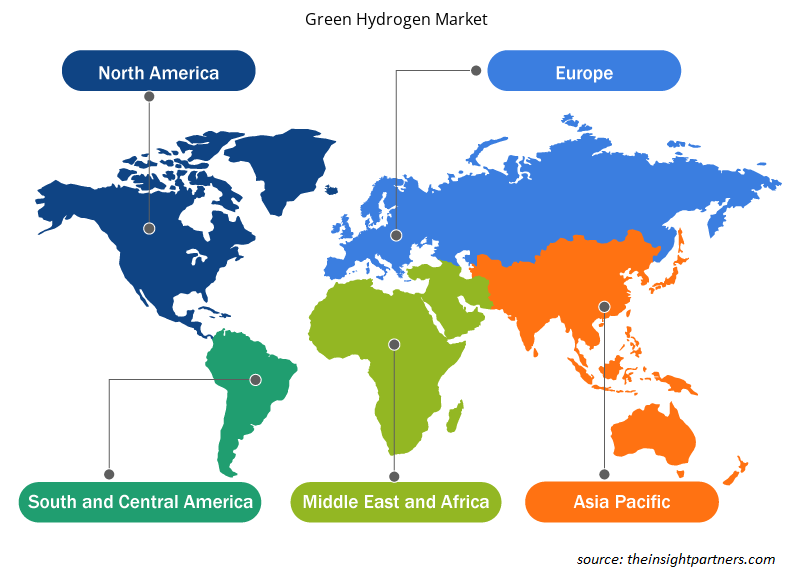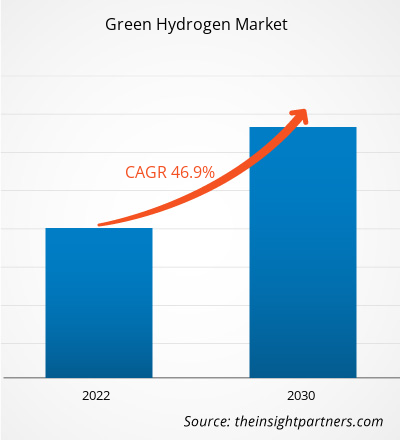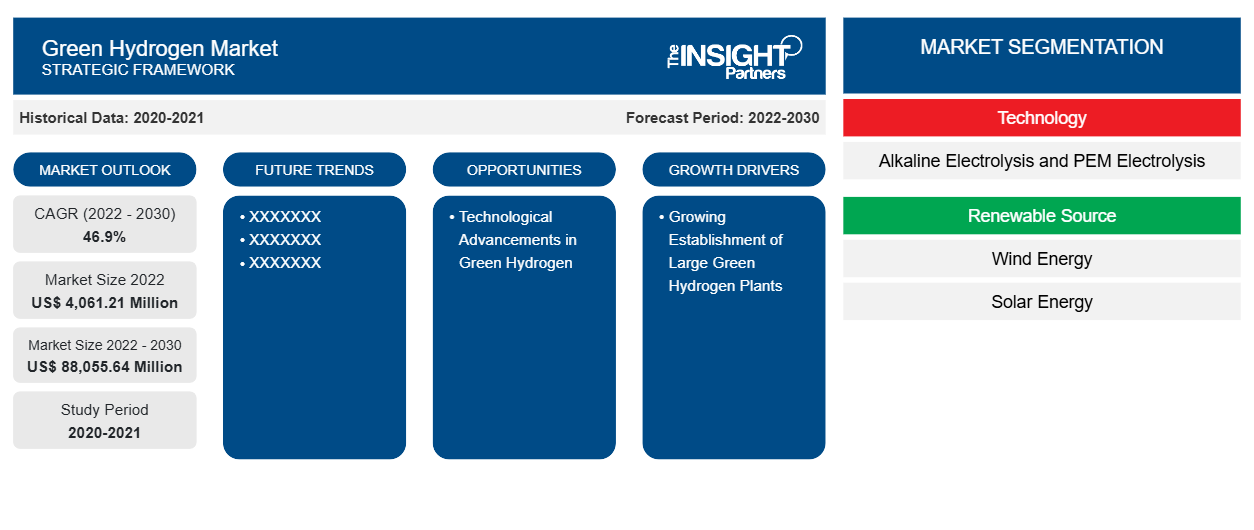من المتوقع أن ينمو حجم سوق الهيدروجين الأخضر من 4،061.21 مليون دولار أمريكي في عام 2022 إلى 88،055.64 مليون دولار أمريكي بحلول عام 2030؛ ومن المتوقع أن يسجل معدل نمو سنوي مركب بنسبة 46.9٪ من عام 2022 إلى عام 2030. ومن المرجح أن يظل الاستثمار الحكومي المتزايد بشكل كبير في الطاقة المتجددة اتجاهًا رئيسيًا في سوق الهيدروجين الأخضر.
تحليل سوق الهيدروجين الأخضر
تدرك الحكومات في مختلف أنحاء العالم مزايا الهيدروجين الأخضر كحل للطاقة النظيفة والمستدامة. وتتخذ تدابير استباقية لدعم تطويره ونشره عبر مختلف القطاعات. ويدفع التركيز المتزايد على إزالة الكربون والتخفيف من آثار تغير المناخ الحكومات إلى إعطاء الأولوية للاستثمارات في الهيدروجين الأخضر كوسيلة للحد من انبعاثات الكربون. على سبيل المثال، في يونيو 2022، قدمت شركة بروتيوم، إحدى شركات طاقة الهيدروجين الأخضر الرائدة في المملكة المتحدة، حلول طاقة صافية صفرية شاملة. وبالتالي، من المتوقع أن تؤدي الاستثمارات المتزايدة في مشاريع الهيدروجين الأخضر إلى خلق فرص جديرة بالتوسع في السوق في السنوات القادمة.
نظرة عامة على سوق الهيدروجين الأخضر
تُستخدم عملية التحليل الكهربائي لإنتاج الهيدروجين الأخضر عن طريق فصل جزيئات الماء إلى أكسجين وهيدروجين باستخدام الكهرباء. تساهم التطورات التكنولوجية في التحليل الكهربائي في تحسين كفاءة وفعالية التكلفة وقابلية التوسع في إنتاج وتخزين واستخدام الهيدروجين الأخضر. تعد تصميمات المحلل الكهربائي المحسنة ومواد الحفاز المتقدمة وظروف التشغيل المُحسَّنة من بين العوامل القليلة التي قد تؤدي إلى كفاءة تحويل طاقة أعلى وأوقات استجابة أقصر وعمر أطول للمعدات. في يوليو 2023، عرض معهد كوريا لأبحاث المعايير والعلوم (KRISS) حلاً محتملاً لإجراء نقل الناقل المتين والفعال لقطب ضوئي مع طبقة واقية لتطوير إنتاج الهيدروجين الأخضر. تعمل مثل هذه التطورات أيضًا على توسيع نطاق تطبيقات الهيدروجين الأخضر. وبالتالي، من المتوقع أن تعمل التطورات التكنولوجية المرتبطة بالهيدروجين الأخضر على تغذية نمو السوق خلال فترة التنبؤ.
قم بتخصيص هذا التقرير ليناسب متطلباتك
ستحصل على تخصيص لأي تقرير - مجانًا - بما في ذلك أجزاء من هذا التقرير، أو تحليل على مستوى الدولة، وحزمة بيانات Excel، بالإضافة إلى الاستفادة من العروض والخصومات الرائعة للشركات الناشئة والجامعات
-
احصل على أهم اتجاهات السوق الرئيسية لهذا التقرير.ستتضمن هذه العينة المجانية تحليلاً للبيانات، بدءًا من اتجاهات السوق وحتى التقديرات والتوقعات.
محركات وفرص سوق الهيدروجين الأخضر
تزايد الطلب على المركبات العاملة بخلايا الوقود لصالح السوق
تستخدم المركبات الكهربائية التي تعمل بخلايا الوقود الهيدروجين كوقود وتستخدم خلايا الوقود لإنتاج الكهرباء، مما يوفر بديلاً نظيفًا وكفؤًا لمركبات محرك الاحتراق الداخلي التقليدية. ومع سعي البلدان إلى الحد من انبعاثات الكربون والانتقال إلى وسائل نقل منخفضة الكربون ، يتزايد الطلب على المركبات الكهربائية التي تعمل بخلايا الوقود في جميع أنحاء العالم. ونتيجة لذلك، يشارك العديد من اللاعبين في السوق في التطوير الاستراتيجي، مثل الشراكات والتعاون والاتفاقيات، لتعزيز عروض منتجاتهم وتلبية الطلب المتزايد على المركبات الكهربائية التي تعمل بخلايا الوقود. ويعزز اعتماد المركبات الكهربائية التي تعمل بخلايا الوقود الحاجة إلى إنتاج الهيدروجين الأخضر، لأنه المصدر الأساسي للوقود في هذه المركبات.
تزايد إنشاء محطات الهيدروجين الخضراء الكبيرة – فرصة في سوق الهيدروجين الأخضر
إن إنشاء مصانع الهيدروجين الأخضر واسعة النطاق يجذب استثمارات كبيرة من القطاعين العام والخاص. في يونيو 2023، أعلنت مجموعة من الشركات عن خطتها لاستثمار 79.75 دولارًا أمريكيًا في مشروع لتوسيع منشأة لإنتاج الهيدروجين ومنشأة لتسييل الهيدروجين في كوينزلاند بأستراليا. تضم مجموعة الشركات شركة Kansai Electric Power Company (اليابان)، وMarubeni Corporation (اليابان)، وIwatani Corporation (اليابان)، وKeppel Infrastructure (سنغافورة)، وStanwell Corporation (أستراليا). ومن المتوقع أن يؤدي ارتفاع تطوير البنية التحتية إلى خلق بيئة إيجابية لتنفيذ الهيدروجين الأخضر في قطاعات مختلفة، مما من المرجح أن يوفر آفاق نمو للاعبين في السوق خلال فترة التوقعات.
تقرير تحليل تجزئة سوق الهيدروجين الأخضر
إن القطاعات الرئيسية التي ساهمت في استخلاص تحليل سوق الهيدروجين الأخضر هي التكنولوجيا، والمصادر المتجددة، والاستخدام النهائي.
- استنادًا إلى التكنولوجيا، تم تقسيم سوق الهيدروجين الأخضر إلى التحليل الكهربائي القلوي والتحليل الكهربائي باستخدام غشاء التبادل البروتوني. احتل قطاع التحليل الكهربائي القلوي حصة سوقية أكبر في عام 2022.
- من حيث مصادر الطاقة المتجددة، تم تقسيم السوق إلى طاقة الرياح والطاقة الشمسية وغيرها. وقد هيمن قطاع الطاقة الشمسية على السوق في عام 2022.
- من حيث صناعة الاستخدام النهائي، تم تقسيم السوق إلى الصناعات الكيميائية والطاقة والأغذية والمشروبات والصناعات الطبية والبتروكيماوية وغيرها. وقد هيمن قطاع الطاقة على السوق في عام 2022.
تحليل حصة سوق الهيدروجين الأخضر حسب المنطقة الجغرافية
ينقسم النطاق الجغرافي لتقرير سوق الهيدروجين الأخضر بشكل أساسي إلى خمس مناطق: أمريكا الشمالية، ومنطقة آسيا والمحيط الهادئ، وأوروبا، والشرق الأوسط وأفريقيا، وأمريكا الجنوبية/أمريكا الجنوبية والوسطى.
تتصدر أوروبا سوق الهيدروجين الأخضر. وقد اتخذت العديد من الدول الأوروبية، بما في ذلك إسبانيا وفرنسا وألمانيا والبرتغال، خطوات للتعاون وبناء خط أنابيب للهيدروجين بحلول عام 2030. وسيسهل هذا الخط نقل حوالي 2 مليون طن متري من الهيدروجين سنويًا من هذه الدول إلى فرنسا. وبينما تتطلع أوروبا إلى تأمين إمداداتها من الطاقة وتسريع الانتقال إلى مستقبل خالٍ من الكربون، يبرز الهيدروجين الأخضر كمورد حيوي وحل رئيسي للحد من الاعتماد على الوقود الأحفوري وتحقيق أهداف مناخية طموحة. وتعد ألمانيا وفرنسا وإيطاليا والمملكة المتحدة من بين الدول الرئيسية العاملة في سوق الهيدروجين الأخضر في أوروبا. وقد اتخذت الحكومة الألمانية بالفعل خطوات لتعزيز اقتصاد الهيدروجين، بما في ذلك اعتماد استراتيجية وطنية للهيدروجين. على سبيل المثال، في مارس 2022، أعلنت ألمانيا عن مساهمة قدرها 572 مليون دولار أمريكي نحو اقتصاد هيدروجين أخضر عالمي جديد. وهذه خطوة مهمة في تعزيز تبني وتطوير حلول الطاقة النظيفة في جميع أنحاء العالم.
رؤى إقليمية حول سوق الهيدروجين الأخضر
لقد قام المحللون في Insight Partners بشرح الاتجاهات والعوامل الإقليمية المؤثرة على سوق الهيدروجين الأخضر طوال فترة التوقعات بشكل شامل. يناقش هذا القسم أيضًا قطاعات سوق الهيدروجين الأخضر والجغرافيا في جميع أنحاء أمريكا الشمالية وأوروبا ومنطقة آسيا والمحيط الهادئ والشرق الأوسط وأفريقيا وأمريكا الجنوبية والوسطى.

- احصل على البيانات الإقليمية المحددة لسوق الهيدروجين الأخضر
نطاق تقرير سوق الهيدروجين الأخضر
| سمة التقرير | تفاصيل |
|---|---|
| حجم السوق في عام 2022 | 4,061.21 مليون دولار أمريكي |
| حجم السوق بحلول عام 2030 | 88,055.64 مليون دولار أمريكي |
| معدل النمو السنوي المركب العالمي (2022 - 2030) | 46.9% |
| البيانات التاريخية | 2020-2021 |
| فترة التنبؤ | 2022-2030 |
| القطاعات المغطاة |
حسب التكنولوجيا
|
| المناطق والدول المغطاة |
أمريكا الشمالية
|
| قادة السوق وملفات تعريف الشركات الرئيسية |
|
كثافة اللاعبين في السوق: فهم تأثيرها على ديناميكيات الأعمال
يشهد سوق الهيدروجين الأخضر نموًا سريعًا، مدفوعًا بالطلب المتزايد من المستخدم النهائي بسبب عوامل مثل تفضيلات المستهلكين المتطورة والتقدم التكنولوجي والوعي المتزايد بفوائد المنتج. ومع ارتفاع الطلب، تعمل الشركات على توسيع عروضها والابتكار لتلبية احتياجات المستهلكين والاستفادة من الاتجاهات الناشئة، مما يؤدي إلى زيادة نمو السوق.
تشير كثافة اللاعبين في السوق إلى توزيع الشركات أو المؤسسات العاملة في سوق أو صناعة معينة. وهي تشير إلى عدد المنافسين (اللاعبين في السوق) الموجودين في مساحة سوق معينة نسبة إلى حجمها أو قيمتها السوقية الإجمالية.
الشركات الرئيسية العاملة في سوق الهيدروجين الأخضر هي:
- إير ليكيد
- شركة سيمنز للطاقة
- شركة كومينز
- شركة ليندي المحدودة
- نيل آسا
- أورستيد ايه/اس
إخلاء المسؤولية : الشركات المذكورة أعلاه ليست مرتبة بأي ترتيب معين.

- احصل على نظرة عامة على أهم اللاعبين الرئيسيين في سوق الهيدروجين الأخضر
أخبار سوق الهيدروجين الأخضر والتطورات الأخيرة
يتم تقييم سوق الهيدروجين الأخضر من خلال جمع البيانات النوعية والكمية بعد البحث الأولي والثانوي، والتي تتضمن منشورات الشركات المهمة وبيانات الجمعيات وقواعد البيانات. فيما يلي قائمة بالتطورات في السوق فيما يتعلق بالابتكارات وتوسيع الأعمال والاستراتيجيات:
- في أكتوبر 2022، وقعت شركة NTPC وشركة Siemens Ltd مذكرة تفاهم بشأن جدوى إثبات فعالية إطلاق الهيدروجين المختلط بالغاز الطبيعي في توربينات الغاز Siemens V94.2 المثبتة في محطة الطاقة الغازية NTPC Faridabad. (المصدر: شركة Siemens Ltd، بيان صحفي/موقع الشركة على الويب/النشرة الإخبارية)
- في ديسمبر 2022، قامت شركة Cummins Inc. بتوريد نظام محلل كهربائي بغشاء تبادل البروتون (PEM) بقوة 35 ميجاوات (MW) لمصنع إنتاج الهيدروجين الجديد لشركة Linde في شلالات نياجرا، نيويورك. (المصدر: Cummins Inc، بيان صحفي/موقع الشركة على الويب/النشرة الإخبارية)
تغطية تقرير سوق الهيدروجين الأخضر والمنتجات النهائية
يوفر تقرير "حجم سوق الهيدروجين الأخضر والتوقعات (2020-2030)" تحليلاً مفصلاً للسوق يغطي المجالات التالية:
- حجم سوق الهيدروجين الأخضر وتوقعاته على المستويات العالمية والإقليمية والوطنية لجميع قطاعات السوق الرئيسية التي يغطيها النطاق
- ديناميكيات السوق مثل المحركات والقيود والفرص الرئيسية
- اتجاهات سوق الهيدروجين الأخضر
- تحليل مفصل لـ PEST و SWOT
- تحليل سوق الهيدروجين الأخضر الذي يغطي اتجاهات السوق الرئيسية والإطار العالمي والإقليمي والجهات الفاعلة الرئيسية واللوائح والتطورات الأخيرة في السوق
- تحليل صناعة سوق الهيدروجين الأخضر والمناظر الطبيعية والمنافسة، وتغطية تركيز السوق، وتحليل خريطة الحرارة، واللاعبين البارزين، والتطورات الأخيرة
- ملفات تعريف الشركة التفصيلية
- التحليل التاريخي (سنتان)، سنة الأساس، التوقعات (7 سنوات) مع معدل النمو السنوي المركب
- تحليل PEST و SWOT
- حجم السوق والقيمة / الحجم - عالمي، إقليمي، بلد
- الصناعة والمنافسة
- مجموعة بيانات إكسل
التقارير الحديثة
شهادات العملاء
سبب الشراء
- اتخاذ قرارات مدروسة
- فهم ديناميكيات السوق
- تحليل المنافسة
- رؤى العملاء
- توقعات السوق
- تخفيف المخاطر
- التخطيط الاستراتيجي
- مبررات الاستثمار
- تحديد الأسواق الناشئة
- تحسين استراتيجيات التسويق
- تعزيز الكفاءة التشغيلية
- مواكبة التوجهات التنظيمية























 احصل على عينة مجانية ل - سوق الهيدروجين الأخضر
احصل على عينة مجانية ل - سوق الهيدروجين الأخضر